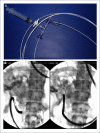Per-oral cholangioscopy
- PMID: 21776429
- PMCID: PMC3136857
- DOI: 10.4161/jig.1.2.15352
Per-oral cholangioscopy
Abstract
Direct endoscopic views of bile duct have been described in literature since the 1970s. Since then rapid strides have been made with the advent of technologically advanced systems with better image quality and maneuverability. The single operator semi-disposable per-oral cholangioscope and other novel methods such as the cholangioscopy access balloon are likely to revolutionize this field. Even though cholangioscopy is currently used primarily for characterization of indeterminate strictures and management of large bile duct stones, the diagnostic and therapeutic indications are likely to expand in future. The following is an overview of the currently available per-oral cholangioscopy equipments, indications for use and future directions.
Figures






Similar articles
-
Biliary interventions using single-operator cholangioscopy.Dig Endosc. 2019 Sep;31(5):517-526. doi: 10.1111/den.13361. Epub 2019 Mar 21. Dig Endosc. 2019. PMID: 30689238 Review.
-
The Role of Peroral Cholangioscopy in Evaluating Indeterminate Biliary Strictures.Clin Endosc. 2019 Nov;52(6):556-564. doi: 10.5946/ce.2019.011. Epub 2019 Jul 16. Clin Endosc. 2019. PMID: 31309767 Free PMC article. Review.
-
Cholangioscopy: where are we now?Curr Opin Gastroenterol. 2009 May;25(3):245-51. doi: 10.1097/MOG.0b013e328329236c. Curr Opin Gastroenterol. 2009. PMID: 19381085 Review.
-
Management of Difficult Bile Duct Stones by Large Balloon, Cholangioscopy, Enteroscopy and Endosonography.Gut Liver. 2020 May 15;14(3):297-305. doi: 10.5009/gnl19157. Gut Liver. 2020. PMID: 31581389 Free PMC article. Review.
-
Endoscopic retrograde cholangiopancreatography: Current practice and future research.World J Gastrointest Endosc. 2021 Aug 16;13(8):260-274. doi: 10.4253/wjge.v13.i8.260. World J Gastrointest Endosc. 2021. PMID: 34512875 Free PMC article. Review.
Cited by
-
Efficacy of SpyGlass(TM)-directed biopsy compared to brush cytology in obtaining adequate tissue for diagnosis in patients with biliary strictures.World J Gastrointest Endosc. 2014 Apr 16;6(4):137-43. doi: 10.4253/wjge.v6.i4.137. World J Gastrointest Endosc. 2014. PMID: 24748921 Free PMC article.
-
Hemobilia from Biliary Angiodysplasia Diagnosed with Cholangioscopy.ACG Case Rep J. 2016 Sep 28;3(4):e132. doi: 10.14309/crj.2016.105. eCollection 2016 Aug. ACG Case Rep J. 2016. PMID: 27807584 Free PMC article.
-
Role of SpyGlass peroral cholangioscopy in the evaluation of indeterminate biliary lesions.Dig Dis Sci. 2014 Oct;59(10):2565-70. doi: 10.1007/s10620-014-3171-x. Epub 2014 May 1. Dig Dis Sci. 2014. PMID: 24788322
-
Current endoscopic approach to indeterminate biliary strictures.World J Gastroenterol. 2012 Nov 21;18(43):6197-205. doi: 10.3748/wjg.v18.i43.6197. World J Gastroenterol. 2012. PMID: 23180939 Free PMC article. Review.
-
Choledochoscopy: An update.World J Gastrointest Endosc. 2021 Dec 16;13(12):571-592. doi: 10.4253/wjge.v13.i12.571. World J Gastrointest Endosc. 2021. PMID: 35070020 Free PMC article. Review.
References
-
- Devereaux CE, Binmoeller KF. Endoscopic retrograde cholangiopancreatography in the next millennium. Gastrointest Endosc Clin N Am. 2000;10:117–133. - PubMed
-
- Takada T, Suzuki S, Nakamura K, Uchida Y, Nomoto T, Yamada A, et al. Percutaneous transhepatic cholangioscopy as a new approach to the diagnosis of biliary disease. Gastroenterol Endosc. 1974;16:106–111. (In Japanese)
-
- Nakajima M, Akasaka Y, Fukumoto K, Mitsuyoshi Y, Kawai K. Peroral cholangiopancreatosocopy (PCPS) under duodenoscopic guidance. Am J Gastroenterol. 1976;66:241–247. - PubMed
-
- Rosch W, Koch H, Demling L. Peroral cholangioscopy. Endoscopy. 1976;8:172–175.
-
- Urakami Y, Seifert E, Butke H. Peroral direct cholangioscopy (PDCS) using routine straight-view endoscope: first report. Endoscopy. 1977;9:27–30. - PubMed
LinkOut - more resources
Full Text Sources
